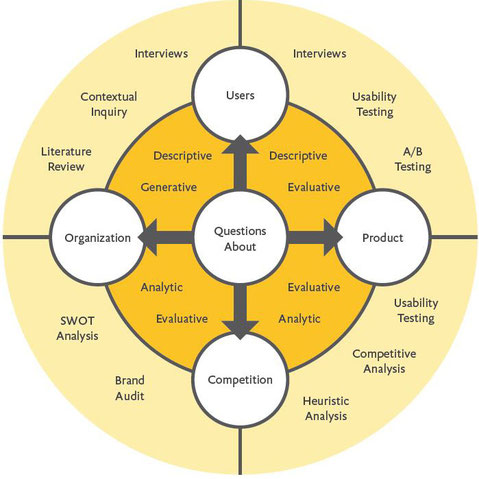Qualitative User Research & Data Analysis
This blog post will provide a brief description of the user research in terms of a qualitative approach and data analysis. After completing my second project work and using the above method to gain a useful insight into the behavior and habits of the users, I thought it would be interesting to present and clarify the procedure I used.

1. Problem Definition
Just as you need a clearly articulated problem to create a solid design solution, a useful research study depends on a clear problem statement. Erika Hall
Considering Erica Hall’s quote, you should start your user research by defining questions you want to be answered. Once the questions are derived, the next step is to define your research problem statements (RPS) to describe the topic and goals of your user research. In this initial phase, you intend to identify WHAT you want to find out.
For example, if your topic is working students and your question is „How do they plan their studies activities?“ then your research problem statement could be, „I will describe how working students plan their studies activities“.
2. Approach Selection
After identifying WHAT you want to find out, you need to move to the question of HOW to approach the research. The topic and nature of your questions will guide your choice of research activities.

In any form of research, we are required to either count things and/or talk to people. It is possible to classify research methods using this distinction. These two types of research and their output data are classified as Quantitative and Qualitative.
If your RPS are based on questions about users themselves and are oriented towards gaining insights about reasons and motivations for their actions, you should use descriptive user research or Ethnography classified as Qualitative Research.
In the further phase, after selecting your research approach your next step is to write a quick description of the study by incorporating previously defined questions, research problem statements, and your choice of research activities.
For example: „I will describe how working students plan their studies activities by conducting interviews and compiling the results“.
3. Planning and preparing the Research
If you choose, for example, to conduct interviews the key issue with interviewing is making decisions about who are the key people to talk to. At this stage, you should recruit representatives of your target group. After recruiting at least 5 respondents (which is enough for an applied research) you can proceed by defining interviews’ guidelines.
4. Data Collection
Data collection will be the following step of your user research. After recruiting the respondents, defining the interview’s structures and guidelines, conducting interviews, the next phase is to transcribe all the interviews to collect data and start with further data analysis.
5. Data Analysis
The process of qualitative data analysis can be conducted in different ways, by the usage of deductive or inductive methods.
Inductive analysis involves discovering patterns, themes and categories in one’s data. Findings emerge out of the data, through the analyst’s interactions with the data, in contrast to deductive analysis where the data are analyzed according to an existing framework. Michael Quinn Patton
If the goal of your user research is to define exactly which components fall into which category to obtain useful data for further reporting and building appropriate case studies, as it was in the case of my 2nd project work, the best way is to use a deductive method. By the usage of the deductive method, you will build categories of analysis and provide answers to initially asked questions. The next step is to code the whole transcribed material based on developed categories and to deduce conclusions by each analysis category. I highly recommend the usage of the MAXQDA tool, a software package for qualitative and mixed methods research which I used for my project work data analysis.
6. Results Report
In addition to many possibilities for presenting your work results, one of them may be to make a case study.
The case study approach to qualitative analysis represents an analysis process to gather comprehensive, systematic, and in-depth information about each case of interest. The analysis process results then in a product - a case study. The term case study can refer to either the process of analysis or the product of analysis or both. The aim of case studies is the precise description or reconstruction of a case.
The case study is a readable, descriptive picture of or story about a person, program, organization, and so forth. It provides to the reader all the information necessary to understand the case in all its uniqueness. The case story can be told chronologically or presented thematically (sometimes both). In my project work, the study narratives were thematically oriented.
Briefly, the process of Constructing Case Studies in 3 steps:

Sources:
Hall, E. (2013). Just Enough Research. A Book Apart, New York
Patton, M. Q., (2002). Qualitative Research & Evaluation Methods. Sage publications, Inc, Thousand Oaks

Write a comment